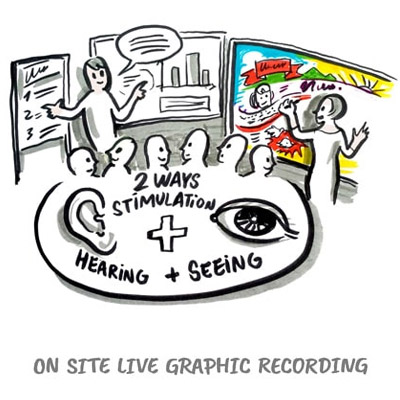This profession has its origin in the the US and can be traced back about 40 years, but it only got famous in the past few years in Europe and is still very new in Asia. The process of graphic facilitation, graphic recording or in short scribing is that during a group discussion, a brainstorm or a conversation in the context of a workshop or a conference, I will listen to what people say, simultaneously synthesise it in my head, find the pattern and visualize the connection of those contents. With the use of graphic, I turn the speech into a drawn piece of work, in big scale and live. It is the art of ‘live-capturing’ complex concepts and words, through illustrations and text into a structured synthesis of visual maps.

Do you wonder why we often say that we do not “see” what a certain thing means? In a complex group communication, people tend to think that they are talking about the same thing but they might not. We are stuck in various meetings or we spend time and money gather key people to work together in a workshop and nevertheless the result of our communication may not bring the solution we wish. How would this be different if we all manage to “see” what we are talking about? In a working session, I help my clients to “see” what has been said. By using graphic recording I “translate” the spoken words into visual concept sketches. By visualise their discussion or conversation, I make it tangible. Therefore, I ensure that they are talking about the same reality and that the communication goes in the same direction.
When People can see what they have said is been turned into a graphic during their discussion and base on that tangible subject they could have a more effective group communication and hence, improve their thinking process. As graphic facilitation transforms lengthy and complex conversation or speech into one big picture, it helps to understand and to retain complicated information. Participants feel heard when their words are recorded and this could enhance their engagement in a workshop too. Hearing + Seeing + Experiencing = better communication result. Graphic facilitation record the workshop as one image and allows participants to easily see where they came from and what is the next step.
Finally, graphic facilitation materialise the workshop into one “take away” visual and digital document. Thus, participants will have something as reminder and to refer to in the future. The soul of a good scribe comes from a good listening skill. The capturing process is about drawing and writing, both equally important, though too often this profession has been mistaken as illustrating or even cartooning. Scriber capture contents, but don’t produce art. It is not about drawing beautiful graphics but using graphic intelligently to turn the audio content into an image, which “speaks a thousand words”. (Tikka Hun, dieKulturvermittlung, 02.07.2015)
Tikka Hun is the founder of the creative studio TAK-TIK. Besides making scribes, she and her partner Valentin Boré also give trainings in graphic recording and are doing sessions design for facilitation workshop based on MG Taylor© Methodology. She has worked and lived in 40 different countries and is currently living again in her homeland Malaysia. Her ultimate trip was a year living in the jungle of Borneo, where she accomplished her “Portrait of Borneo” series that comprise paintings of wild orang-hutans and monkeys.
Source: http://diekulturvermittlung.at/2015/07/der-beruf-eines-scribers/?lang=en

